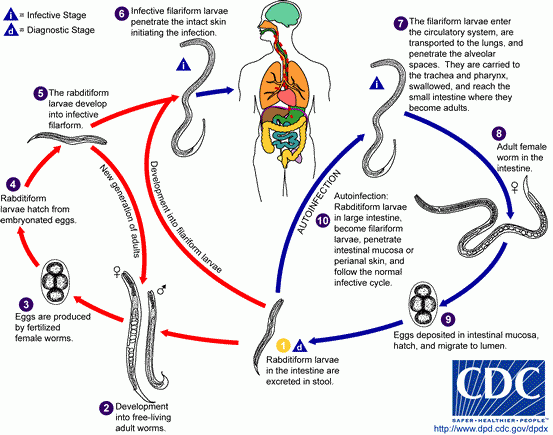Deadly Parasitic Roundworms Transmitted Through Organ Transplants [PHOTOS]

A rare parasitic roundworm was transmitted to three whole organ transplant recipients last year - the Centers for Disease Control and Prevention (CDC) report that the Strongyloides stercoralis intestinal nematode hitched a ride on the heart, kidneys, pancreas, and liver of a single organ donor to infect the vulnerable targets.
Because it's so uncommon in the United States, organ donation organizations have no existing guidelines in place to screen organ donors for the Strongyloides parasite- that may change after the outbreak reported in this week's Morbidity and Mortality Weekly Report (MMWR).
"Donor-derived Strongyloides infection might be more common than previously believed," stated the CDC report.
Strongyloides stercoralis, also known as threadworm, is endemic to tropical and subtropical regions, infecting as many as 30 million people in 70 countries worldwide; cases in the United States are typically seen in people who had skin contact with contaminated soil while visiting other countries.
According to Medline Plus, the tiny young roundworms burrow through skin into the bloodstream, from which they swim into the lungs. From there they crawl into the throat, are swallowed into the stomach, and pass into the small intestine, where they attach to the intestinal wall and start laying eggs that hatch into larvae.
The larvae can either exit the body in feces and lie in wait for another host, or reenter through the skin around the anus.
The roundworm typically causes no symptoms in otherwise healthy people, but people with weakened immune systems, like the recipients of organ transplants, are at serious risk of strongyloidiasis. In those patients, the roundworm is fatal more than half the time.
Most severe cases spring up when chronic parasitic infections reactivate after immunosuppressive therapy. Donor-derived Strongyloides infections seem to be rare, and it's especially difficult to prove whether the parasite came from a donor organ if the recipient has visited regions where the roundworm is common. Between 2009 and 2012, the CDC found only seven cases of donor-derived strongyloidiasis.
In this case, the source of the Strongyloides parasite was a 24-year-old man in Pennsylvania who died of multiple gunshot wounds after a 9-day hospitalization in July 2012. According to the CDC report, his mother told doctors that he had visited Puerto Rico regularly. Because he was otherwise healthy, however, no one considered testing him for parasitic infection.
His heart, kidneys, pancreas, and liver were transplanted into four recipients the day after he died.
The left kidney and pancreas went to a 64-year-old man with diabetes and renal disease who had never traveled outside the United States, who was hospitalized with nausea, anorexia, and stomach pain nine weeks after his transplant. Doctors diagnosed strongyloidiasis after finding adult worms in his stool samples and larvae in his urine. Luckily for him, treatment with ivermectin killed off the roundworms within three days.
Antibody tests confirmed that the parasite arrived after the organ transplant and was not a previous infection taking advantage of the patient's weakened immune system. In October 2012, the United Network for Organ Sharing reported the case to the CDC, which reached out to the other organ recipients. All except one turned out to have been infected.
A 14-year-old boy with renal disease received the other kidney. He was diagnosed with strongyloidiasis 10 weeks later, and also recovered after ivermectin treatment.
The other two were not so lucky. The liver recipient, a 66-year-old man with a history of liver failure, died several days after his organ transplant; an autopsy showed no signs of Strongyloides infection, and the cause of death was unclear.
The heart recipient, a 59-year-old with weakened heart muscles, came down with a respiratory illness seven weeks after the transplant. A bronchoscopy revealed Strongyloides larvae in his lungs, and he was quickly started on ivermectin treatment. Unfortunately, his immune system was so weak that other bacterial diseases attacked his nervous system. Four weeks later, he was taken off life support and died.
The CDC's report suggests developing guidelines for testing organ donors, especially those who have traveled to Strongyloides endemic areas, in order to "improve transplant safety in solid organ recipients at risk for Strongyloides infection."
American Society for Transplantation guidelines recommend Strongyloides screening for organ recipients who are from regions where the roundworms are common, but say nothing about donor screening.
That's because screening requires a certain amount of cooperation from the organ donor - the gold standard for diagnosis is analyzing at least three stool samples for the parasite's larvae, which "might not be feasible in patients who have poor gastrointestinal function or are brain dead." Antibody tests are somewhat less reliable, but can help identify donor infections in enough time to warn and treat organ recipients against the parasite proactively.
In addition, rapid communication between organ transplant organizations, medical centers, and public health officials can help prevent or quickly deal with cases of suspected disease transmission, especially when multiple organs are coming from a single donor.
"Advances in these areas might be life-saving for immunocompromised hosts," concluded the report.
Published by Medicaldaily.com



























